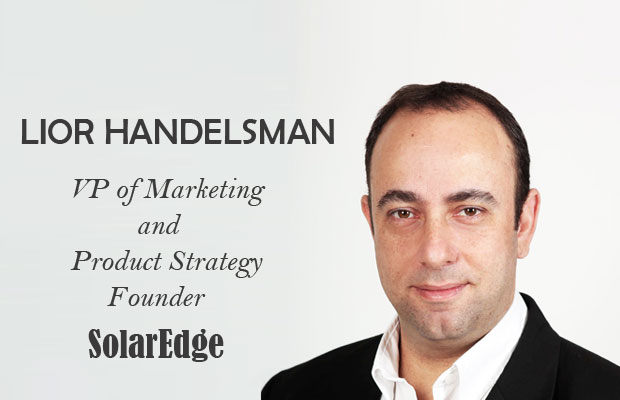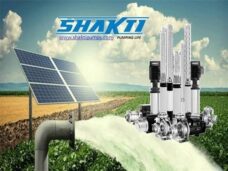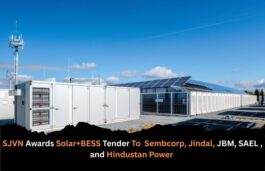
Q. Please give us an overview of SolarEdge’s India operations and product offerings? What are the new products you are planning to bring in India?
The first SolarEdge system was installed in India approximately three and a half years ago and the system has performed well, surpassing the customer’s expectations. SolarEdge systems have been installed on the buildings of prestigious businesses in India and we have received repeat orders from local customers. With a complete portfolio of 3-phase commercial DC optimized inverters, SolarEdge is well poised to become a major player in commercial roof-top & utility-scale PV installations.

Lior Handelsman, VP, Marketing & Product Strategy & Founder | SolarEdge
In order to support the current growth of the Indian PV market, SolarEdge has recently taken steps to strengthen its business position in the country with a new office and leadership. Looking to expand its footprint in the Indian PV market, SolarEdge appointed a new country manager, added an office, and is currently recruiting a local team. SolarEdge is positioned to play an important and leading role in the Indian solar industry.
Based on SolarEdge’s track record of optimizing commercial-scale PV systems, SolarEdge recently launched larger-capacity, three-phase inverters up to 100kW. These new commercial inverters offer the benefits of both central and string inverters, but without any of the setback, such as needing a forklift, requiring a specialized team for maintenance, increased system downtime. With simple and cost-efficient installations, pre-wiring, and easy maintenance, the larger-capacity inverters save on AC BoS costs and can minimize downtime to the impacted string. In addition, the new inverters provide smart energy management control.
On the cutting-edge of PV safety and module-level power electronics, SolarEdge just unveiled its next generation S-Series power optimizer. The S-Series power optimizer has up to 40% higher power density, is 38% smaller, and introduces a new innovative safety feature that extends safety to the connector level. The new safety feature is designed to detect heat abnormalities and initiate shutdown before an arc occurs in order to prevent potential fires. The S-Series power optimizer is expected to be available in 2018.
Q. Who are your competitors and how are you planning to compete with the Chinese players?
It is hard to evaluate products that do not yet exist. Once we see specific products we can make a better assessment. There are definitely signs that Chinese manufactures are planning to enter the MLPE market. We especially saw the impact of this in solar industry with panels. However, panels and inverter solutions are very different. Panels are commodities whereas inverters are the brain of the PV system. MLPE technology is even more technologically complex than inverters. Developing MLPE technology, with high efficiencies and reliability, are likely to prove challenging.
Q. Please tell us about the benefits that SolarEdge offers commercial PV systems?
Inverters selection is significant, because while they only account for 10% of actual system cost, they end up influencing 30% of the system cost (in terms of BoS, labor, etc), manage 100% of system production, and control O&M expenses. The benefits that SolarEdge offers are:
Reduced BoS costs with up to 15kW strings – longer than 1500v inverters, but without any of the specialized hardware requirements Increased lifetime revenue with module-level power optimization allowing for more modules on the roof and more energy production thanks to eliminating energy loss from module-level mismatch Decreased O&M costs with future compatibility, longer warranties, and improved PV asset management due to module-level monitoring. This can mean less trips onsite and less time spent onsite.
Enhanced safety with SafeDC™ which reduces DC voltage in PV wires to a safe level whenever inverter or grid are shut down for safety during installation, maintenance, firefighting, & other emergencies
Q. Boviet Solar recently partnered with SolarEdge Technologies, Inc. to include SolarEdge solar power inverters with its 60-cell mono smart solar modules. Share us more about the partnership and advantages of integrating SolarEdge inverters?
This was actually a mistake. Boviet Solar embedded our power optimizers into its modules. We work with a number of different module manufactures such as: Axitec, AxSun Solar, Canadian Solar, DMEGC, JA Solar, Jinko Solar, and Kioto Photovoltaics.
There are a number of advantages throughout the value chain. For instance, the cost of the junction box is eliminated because the power optimizer replaces the junction box. Manufactures benefit from: Differentiation among the commoditized environment, leverage growing demand for MLPE, expanded product portfolio with premium pro-duct, increased revenue opportunity with higher-margin product, and material savings. Installers benefit from: Savings on labor, simplified purchasing and inventory, easier site logistics. System owners benefit from: Meets advanced safety codes, full system designed to work together.
With our latest generation of embedded power optimizers, we created a modular design to allow for manufacturing flexibility so that module manufacturers can quickly adjust manufacturing according to demand. We have done this by designing a fixed base with bypass diodes and then two separate covers. One cover holds a power optimizer, while the other is for a standard junction box with a bypass connector.
Q. Is there any plan to form similar partnership with Indian manufacturer (s) to offer self-contained solar module, ready for installation with the power inverter?
SolarEdge is in-touch with key market players and is constantly pursuing mutually-beneficial business opportunities in this area. Once we have more concrete information, we will make it public.
Q. Early this year in March SolarEdge Technologies started rolling out its new complete residential solution throughout Europe. Combining PV inverter, storage and home automation, the complete residential solution manages and monitors solar energy generation, electricity consumption, energy storage, and device control that enables homeowners to increase self-consumption and energy independence. When do you plan to roll out similar residential solution in India and other market places?
SolarEdge launches products and solutions based on market need, demand, and local requirements. We tailor our solutions to each individual market.
Q. What potential do you see for complete residential solution in the Indian market?
The residential market in India is more localized at the moment and we strongly believe system prices will become more competitive due to module price decline. This should lead to the residential sector significantly opening up. SolarEdge with its DC optimized inverter and remote monitoring platform is poised to play a major role in residential market. At SolarEdge, we look to leverage our leadership experience in major residential markets like the US and Europe. We hope to repeat our success story in the PV residential market segment in India.
Q. Tell us in detail about the company’s award-winning HD-Wave inverter that set a new record for the California Energy Commission (CEC), by reaching 99% weighted efficiency?
SolarEdge’s HD-Wave inverter introduced a novel approach to inverter design and significantly decreased inverter size and weight and achieved record efficiency. By using multi-level switching and digitizing the conversion process to create a cleaner sine wave, SolarEdge’s HD-Wave inverter broke the mold for inverters and dramatically increased power density.
Q. What type of monitoring analysis of the PV system is required to optimize the production, the output and the quality of service of a solar power plant?
Monitoring at the module-level is key to increase system uptime and improve PV asset management. However, it is the com-bination of module-level monitoring with remote troubleshooting that are key. This combination means less trips to site, less time spent on site, and higher system uptime.
Q. Government of India recently released final GST rates under the new indirect tax regime proposed to be rolled out from July 1. What kind of effect do you see in your business in India?
We are actively watching the developments in the GST roll out and its implications on solar inverters. We are further awaiting clarification to understand the full impact on project costs.



























